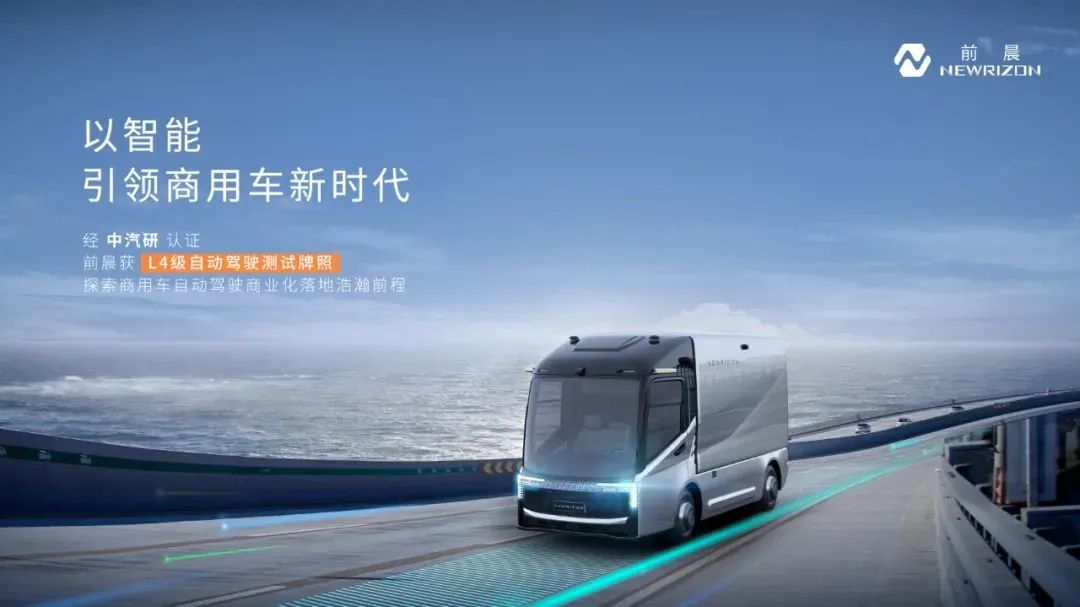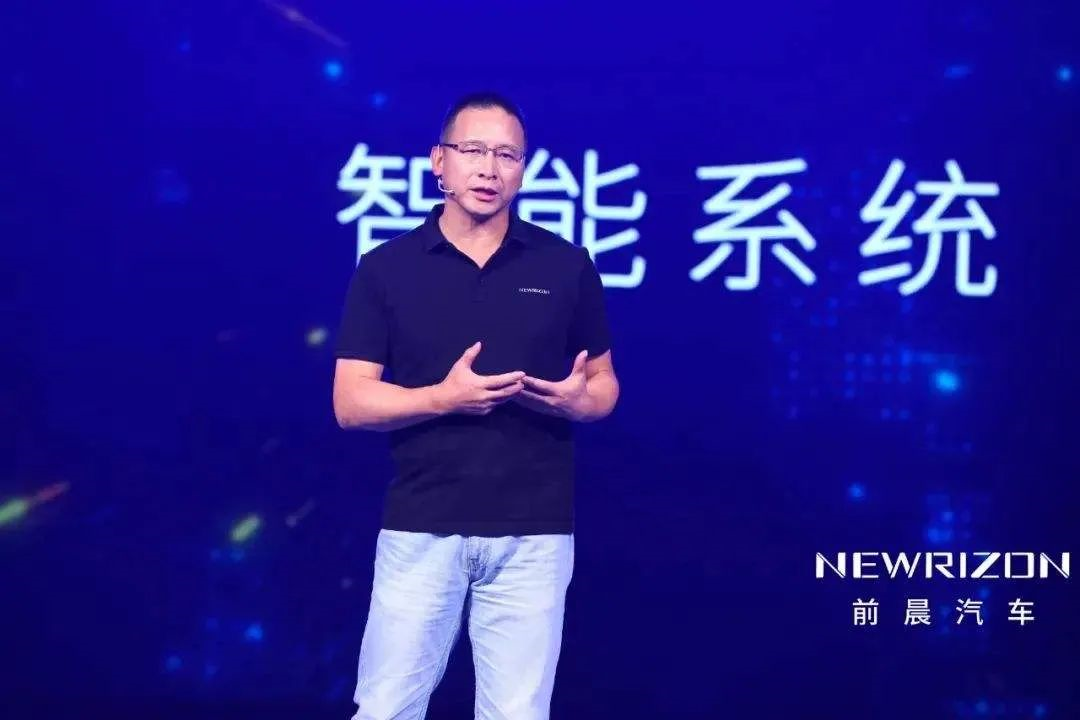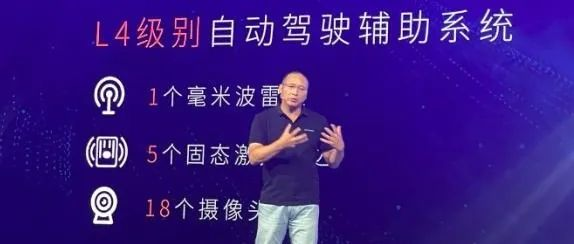Author: Feng Jingang
After the battle of autonomous driving in the new energy passenger vehicle market, now the battle of autonomous driving in the new energy commercial vehicle market has officially started.

On March 7th, Qianchen Motors, a new force in commercial vehicle manufacturing, officially announced that it has obtained the L4 level autonomous driving license certified by China Automotive Technology and Research Center (CATARC), which means that the competition for autonomous driving technology in the new energy commercial vehicle market is becoming increasingly fierce.

Previously, Electric Momentum has reported on Qianchen Motors and its founder and CEO Huang Chendong. For details, please refer to “Huang Chendong: Pioneer of Star Trek to a New Journey”.
On March 2nd, Huang Chendong accepted interviews from several media outlets including Electric Momentum. He shared with us the original intention and product layout of Qianchen Motors, as well as answered questions about their thinking and layout in autonomous driving.
Positioning as a New Force in Commercial Vehicle Manufacturing
Going back to September 25, 2020, Shanghai Qianchen Vehicle Technology Co., Ltd. was officially established, and Qianchen Motors was born.
It is reported that the name Qianchen, meaning “the path ahead and the prospect of dawn”, was chosen for the company.
The English name of Qianchen Motors is “NEWRIZON”. The English name of the NASA Pluto explorer that Huang Chendong participated in, New Horizons, means a new beginning for the future.
The reason why Qianchen Motors was established, Huang Chendong frankly said, is that he has been engaged in technology research and development for many years, and now he wants to use the power of technology to change commercial vehicles, for example, to improve the working environment of commercial vehicle drivers and promote the transformation of this industry.

Therefore, he has set the brand vision of Qianchen Motors as “technology conveying warmth” and using the power of technology to create happiness for more people.
Currently, Qianchen Motors has more than 160 employees, with R&D personnel accounting for more than 50%.
Huang Chendong shared the general composition of the employees, mainly composed of three aspects: first, NIO, including those who started a business with Huang Chendong and those who left NIO before; second, Huang Chendong’s former colleagues at SAIC; third, social recruitment.
Huang Chendong described the team as “special forces”, young, highly competent, especially with genes in the fields of the Internet and autonomous driving. This talent attribute also constitutes the brand characteristics and product form of Qianchen Motors, forming a difference from traditional car companies.# Huang Chendong also disclosed the financing situation of the company. They have completed two rounds of financing, the first round was 10 million USD and the second round was 50 million USD. Currently, they are working on a new round of financing (B+) with an amount of approximately 40-60 million USD. They plan to launch the third round of financing (C) in the second half of this year.
On August 5, 2021, Qianchen Auto held a brand and product launch conference at the Shanghai Auto Exhibition Center. In terms of enterprise positioning, Qianchen intends to play the role of a new energy vehicle newcomer in the commercial vehicle field, hoping to promote the development of commercial vehicles towards new energy, networking, and intelligence.
The reason for entering the new energy commercial vehicle market, Huang Chendong believes, is that first, the development of the commercial vehicle market is slower than that of passenger vehicles, and it is currently a blue ocean. It is expected to erupt in 2025, while the passenger vehicle market is already a red ocean. Second, for Qianchen auto familiar with passenger vehicle technology, making commercial vehicles is a downgrade in technology.
Huang Chendong predicts that the new energy commercial vehicle market will mature by 2025, and the sales ratio will reach at least 20%.
Regarding the future evolution of the new energy commercial vehicle market, Huang Chendong said that commercial vehicles are ultimately production tools, so the vehicle must be connected with the cargo and the cargo warehouse, forming a smart ecological network in which all data can be connected. Only in this way can the overall transportation efficiency of the logistics industry be improved, as well as its deployment efficiency, and so on.
Short-Term OEM, Long-Term Self-Producing
At last year’s brand and product launch conference, Qianchen released two models, iC1 and EC1. Among them, iC1 is the flagship concept car, expected to be launched at the end of this year. EC1 is a production vehicle co-developed by Qianchen Auto and China National Heavy Duty Truck Group West Co., Ltd. It was already off the line and delivered on October 29th last year.
Huang Chendong stated that EC1 was jointly developed with Qianchen and National Heavy Duty Truck Group West Co., Ltd. Qianchen mainly redeveloped a forward-developed chassis and used National Heavy Duty Truck Group West Co.’s body for the chassis, using lightweight materials, which made it about 400kg lighter and using a flat battery pack that was water-cooled, making it more reliable and longer-lasting.
In terms of the driving aspect, EC1 also uses a coaxial elevator bridge, which is integrated at the rear axle, making the layout structure of the whole vehicle simpler and more compact, while also improving the energy recovery. In terms of the control software on the whole vehicle and battery, Qianchen developed both, allowing the software to be upgraded so the vehicle can have better and more efficient performance in different regions.For the upcoming iC1, Huang Chendong revealed in advance that the mass-produced car is similar to the one presented at the conference last year, with optimized chassis and some minor adjustments, and has strengthened its design in terms of appearance and humanized experience. This car can be called affordable and profitable with its user-friendly design.
Based on the leading position of intelligent network commercial vehicle brand positioning, Huang Chendong also disclosed the product layout of Qianchen Motors. First, the release of light trucks last year, followed by the launch of heavy-duty truck platform with automatic driving this year, and then the release of heavy-duty truck products next year, and finally, entering the VAN box truck market in 2024.
In terms of power, all products of Qianchen Motors are driven mainly by pure electricity and also support battery replacements. In addition, some heavy-duty truck products will be equipped with hydrogen fuel cell technology solutions.
Huang Chendong stated that among the three types of products, light trucks and trucks are the foundation, undertaking volume tasks, and collecting data feedback to upgrade product capabilities, such as automatic driving, while heavy-duty trucks serve as sales supplements.
In terms of annual sales volume, Huang Chendong also made predictions. The EC1 model, which was launched at the end of last year, has sold over 400 units including orders, and will exceed 1,000 units in total deliveries this year. The iC1 model, which will be launched at the end of this year, is expected to deliver more than 100 units, and the deliveries next year will reach tens of thousands.
Regarding profits, Huang Chendong frankly stated that light trucks are relatively difficult to profit from, while heavy-duty trucks will generate certain profit margins.
Regarding the path of car manufacturing, Huang Chendong stated that because Qianchen Motors is still small, finding a contract producer (FAW Jiefang) is the most economical way. When Qianchen’s volume grows, it will gradually find ways to apply for car manufacturing qualifications and build its own production factory.
As a new force in the industry, in addition to innovating product experience, Qianchen Motors is also planning for online user experiences. For this reason, Qianchen Motors has developed an APP.
Huang Chendong stated that the APP, as a product that directly confronts C-end users, was born with the original intention. It can not only realize various control functions, such as vehicle and fleet management but also provide news, shopping, community forums, and leisure and entertainment, thus creating a complete online service ecosystem for “card friends”.
At the same time, the Qianchen APP can experience the same technological experience as a passenger car. It can turn on the air conditioner in advance, remotely lock the car, provide intelligent navigation, human-machine interaction, read the latest industry trends during charging breaks, or interact with card friends on the community forum, watch videos, share daily life, etc., all of which can earn Qianchen’s points and be used for shopping in Qianchen’s mall.
This is the new trend.黄晨东 also said that for a car owner, if he has a fleet, even with 3 cars, 5 cars, or 10 cars, this APP can help him manage his fleet. He can check some key information about each car in the fleet in real-time, including the car’s driving track, energy consumption, mileage, location, etc.
In addition, the various data of the drivers in the fleet can be ranked horizontally, so that for those with regional driving requirements, it can also support real-time electronic fence alarms, achieving all-round management of vehicles and drivers.
Aiming at Advanced Autonomous Driving
Autonomous driving is one of the most popular technologies among new forces. Its ingenuity lies in not only redefining products but also attracting the attention of the capital market.
As the first commercial vehicle new force, with many employees from NIO, Qianteng Automobile naturally knows the value of autonomous driving and focuses on strengthening the development and control of this technology.
For example, in the autonomous driving platform, Qianteng Automobile strives to conduct independent research and development on full-stack software, supports the parallel evolution of L3-L5 autonomous driving, and meets the implementation of unmanned driving in multiple scenarios, and can also be expanded.
In the autonomous driving eco-chain built by Qianteng, core components such as chips and sensor systems are supported by well-known domestic and foreign industry-leading companies, such as Qianxun’s high-precision map data integration, Hesai and Suteng’s high-perception system, and Horizon’s software and hardware integrated platform.
In terms of autonomous driving application scenarios, Qianteng is mainly divided into two categories: closed scenarios, including ports, closed parks, mining areas, etc., with a market scale expected to exceed hundreds of billions; mainline logistics, such as expressways, with a market scale expected to reach trillions.
With the L4 autonomous driving license certified by CARI, it marks that Qianteng has achieved further progress in exploring the commercialization and landing of autonomous driving.
It is expected that in December of this year, Qianteng’s autonomous driving heavy trucks will begin demonstration operations at a production level. In June 2023, the autonomous driving heavy trucks will be officially put into production. In June 2023, the autonomous driving urban area will begin demonstration operations at a production level, and will continue to iterate in 2024.
Huang Chendong’s Thoughts on Autonomous Driving
Currently, the autonomous driving products in the new energy commercial vehicle market are mainly at L1-L2, and the research and development efforts of various traditional commercial vehicle manufacturers are also in this area.
Huang Chendong said that Qianteng has already conducted research and development on basic assistive driving functions in L1-L2, and the focus on L4 is mainly to lay out in advance. In addition, given the development of policies and markets at home and abroad, the conditions for the development of L4 have become mature.
However, in terms of application, Huang Chendong also pointed out that L4 can still only be used in specific places, such as mines, ports, etc. If it is desired to be used in mainline logistics, it may still take several years.When asked about the differences between FAW’s autonomous driving and traditional companies, Huang Chendong shared five points:
-
FAW’s autonomous driving system is developed in-house and the internal systems are fully connected.
-
The integrity of the autonomous driving technology, including software, redundancy, and control technology.
-
FAW has FOTA iterative ability. Other companies have not mentioned having this ability.
-
FAW’s team has experience developing autonomous driving for passenger cars. Transitioning to commercial vehicle autonomous driving is a reduction in technical difficulty and easier to implement.
-
FAW is based on an electric vehicle platform for L4, while other companies are based on an oil vehicle platform. The reaction speed of the two platforms will differ at L4, and the value will be completely different.
One of FAW’s visions is to improve the operation efficiency and money-making ability of its users and release labor. Huang Chendong believes that there are three places where money can be saved through autonomous driving commercial vehicles:
-
After implementing autonomous driving, fewer drivers can be used.
-
Electric vehicles have energy recovery, and energy consumption can be saved through technical advantages.
-
Some aftersales service costs can be saved through big data.
Regarding whether autonomous driving improves safety, Huang Chendong believes that the concept of “zero accidents” is extreme. If there are both autonomous driving and human driving, the number of passive accidents may not decrease. However, if everything is autonomous driving, the incidence of accidents will be reduced by several orders of magnitude.
Regarding the development path of autonomous driving, there is controversy in the industry over the vision-based route and the lidar-based route.
Huang Chendong stated that both routes have their own characteristics. For example, Tesla insists on the vision-based route, which, if the data is processed well, can become the equivalent of human eyes, which is very impressive.
However, to process it properly, inexpensive cameras may not be sufficient and better cameras may be required, which will increase system costs. Therefore, it remains to be seen whether the cost of improving vision-based systems or reducing the cost of lidar-based systems will be faster.
In addition, lidar has a feature that performs well in any weather conditions, while vision-based systems may have issues if the camera is obstructed by mud. Therefore, Huang Chendong believes that a combination of the two is currently the best approach. In the future, the cost will determine which route will be chosen. Ultimately, the technology is capable of achieving both.
Done.
This article is a translation by ChatGPT of a Chinese report from 42HOW. If you have any questions about it, please email bd@42how.com.
